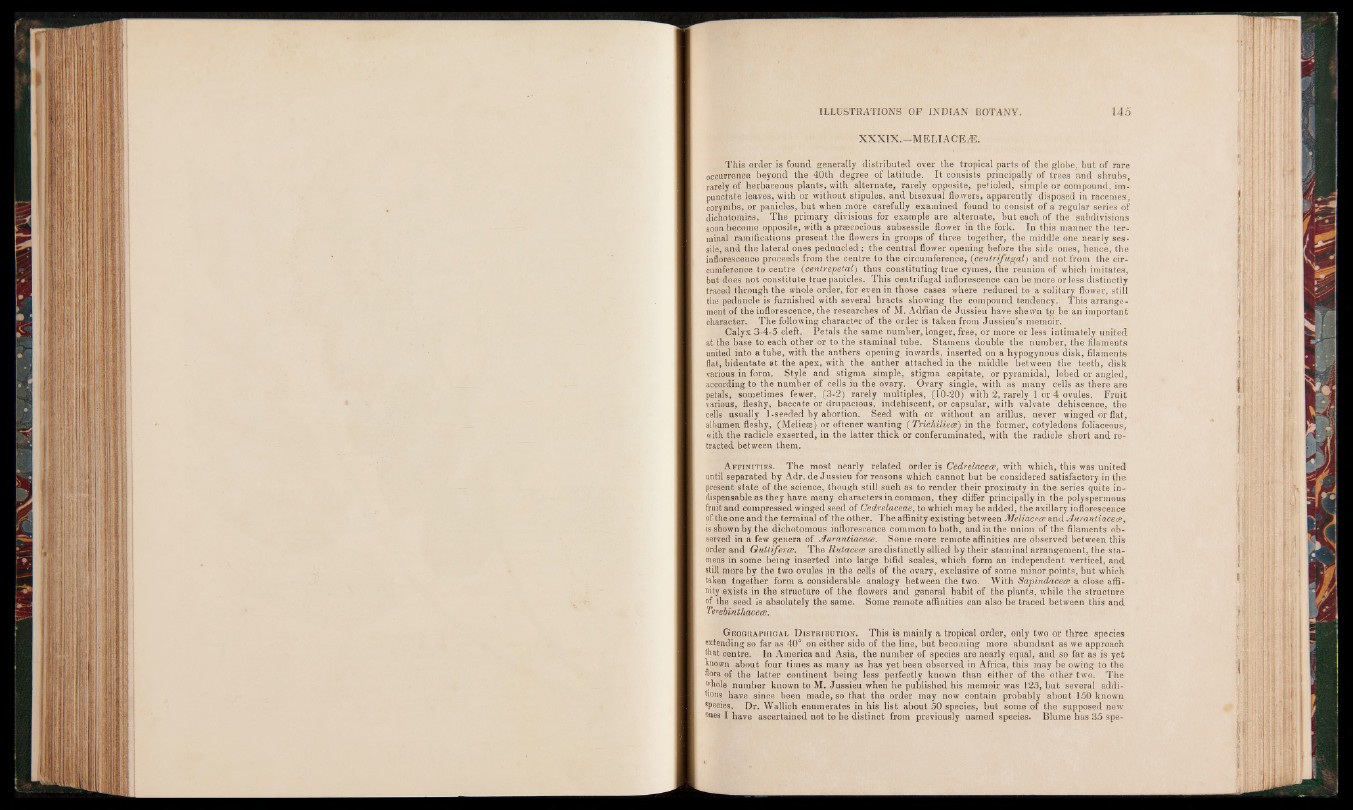
XXXIX.—M E LI A CEA3.
This order is found generally distributed over the tropical parts of the globe, but of rare
occurrence beyond the 40th degree of latitude. It consists principally of trees and shrubs,
rarely of herbaceous plants, with alternate, rarely opposite, petioled, simple or compound, im-
punctate leaves, with or without stipules, and bisexual flowers, apparently disposed in racemes,
corymbs, or panicles, but when more carefully examined found to consist of a regular series of
dichotomies. The primary divisions for example are alternate, but each of the subdivisions
soon become opposite, with a precocious subsessile flower in the fork. In this manner the terminal
ramifications present the flowers in groops of three together, the middle one nearly sessile,
and the lateral ones peduncled; the central flower opening before the side ones, hence, the
inflorescence proceeds from the centre to the circumference, (centrifugal) and not from the circumference
to centre (centrepetal) thus constituting true cymes, the reunion of which imitates,
but does not constitute true panicles. This centrifugal inflorescence can be more or less distinctly
traced through the whole order, for even in those cases where reduced to a solitary flower, still
the peduncle is furnished with several bracts showing the compound tendency. This arrangement
of the inflorescence, the researches of M. Adrian de Jussieu have shewn to be an important
character. The following character of the order is taken from Jussieu’s memoir.
Calyx 3-4-5 cleft. Petals the same number, longer, free, or more or less intimately united
at the base to each other or to the staminal tube. Stamens double the number, the filaments
united into a tube, with the anthers opening inwards, inserted on a hypogynous disk, filaments
flat, bidentate at the apex, with the anther attached in the, middle between the teeth, disk
various in form. Style and stigma simple, stigma capitate, or pyramidal, lobed or angled,
according to the number of cells in the ovary. Ovary single, with as many cells as there are
petals, sometimes fewer, (3-2) rarely multiples, (10-20) with 2, rarely 1 or 4 ovules. Fruit
various, fleshy, baccate or drupacious, indehiscent, or capsular, with valvate dehiscence, the
cells usually 1-seeded by abortion. Seed with or without an arillus, never winged or flat,
albumen fleshy, (Meliem) or oftener wanting ( Trichilieee) in the former, cotyledons foliaceous,
with the radicle exserted, in the latter thick or conferuminated, with the radicle short and retracted
between them.
Affinities. The most nearly related order is Cedrelacece, with which, this was united
until separated by Adr. de Jussieu for reasons which cannot but be considered satisfactory in the
present state of the science, though still such as to render their proximity in the series quite indispensable
as they have many characters in common, they differ principally in the polyspermous
fruit and compressed winged seed of Cedrelaceae, to which may be added, the axillary inflorescence
of the one and the terminal of the other. The affinity existing between Meliace.ce and A urantiaceee}
is shown by the dichotomous inflorescence common to both, and in the union of the filaments observed
in a few genera of Aurantiacece. Some more remote affinities are observed between this
order and Gultiferce. The Rutacece are distinctly allied by their staminal arrangement, the stamens
in some being inserted into large bifid scales, which form an independent verticel, and
still more by the two ovules in the cells of the ovary, exclusive of some minor points, but which
taken together form a considerable analogy between the two. With Sapindacece a close affinity
exists in the structure of the flowers and general habit of the plants, while the structure
of the seed is absolutely the same. Some remote affinities can also be traced between this and
Terebinthacece.
G eographical D istribution. This is mainly a tropical order, only two or three species
extending so far as 40° on either side of the line, but becoming more abundant as we approach
that centre. In America and Asia, the number of species are nearly equal, and so far as is yet
known about four times as many as has yet been observed in Africa, this may be owirlg to the
flora of the latter continent being less perfectly known than either of the other two. The
whole number known to M. Jussieu when he published his memoir was 125, but several additions
have since been made, so that the order may now contain probably about 150 known
species. Dr. Wallich enumerates in his list about 50 species, but some of the supposed new
ones I have ascertained not to be distinct from previously named species. Blume has 35 spe